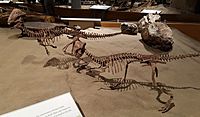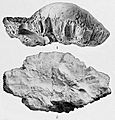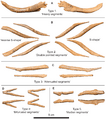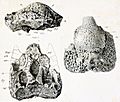Stegoceras facts for kids
Quick facts for kids StegocerasTemporal range: Late Cretaceous
|
|
|---|---|
 |
|
| Two reconstructed S. validum skeletons, Royal Tyrrell Museum | |
| Conservation status | |
|
Fossil
|
|
| Scientific classification | |
| Kingdom: | |
| Phylum: | |
| Class: | |
| Superorder: | |
| Order: | |
| Infraorder: | |
| Family: | |
| Genus: |
Stegoceras
Lambe, 1902
|
| Species: |
S. validum
|
| Binomial name | |
| Stegoceras validum |
|
Stegoceras was a small dinosaur that ate plants. It had a very large head with a super thick skull. Scientists think this dinosaur might have used its strong head to butt other Stegoceras in contests. Many fossils of Stegoceras and other similar dinosaurs called pachycephalosaurs have been found. These fossils were discovered in Alberta, Canada, and Montana, USA.
Discovering Stegoceras
Stegoceras was a dinosaur that lived in groups. They probably stayed in small herds near coasts and in higher lands. If danger came, running away was likely their main defense. Stegoceras lived a long time ago, during the late Cretaceous period. This was near the end of the Mesozoic Era, which is also known as the Age of Reptiles. They lived about 76 to 65 million years ago. The first Stegoceras fossil was found in 1889.
How Strong Was the Stegoceras Skull?
Scientists have studied the skulls of Stegoceras fossils. Images from inside the skull showed two layers of strong bone. These layers surrounded a spongy, air-filled space. This structure made some scientists wonder if the skull was truly strong enough for head-butting.
To find out, scientists used special computer scans. These are called CT scans. They scanned the skulls of Stegoceras and also skulls of modern animals. Then, they made 3D computer models of the heads. This allowed the team to test how much stress the different skulls could handle.
The results were amazing! Stegoceras' head was able to withstand a lot of stress. It was even stronger than the skulls of some modern animals known for head-butting. For example, it was stronger than the skull of a bighorn sheep. This suggests that Stegoceras really could have used its head for powerful impacts.
Images for kids
-
Partial dome CMN 515, lectotype of S. validum, shown from the right and underside
-
CT images of juvenile, flat-headed AMNH 5450 ("Ornatotholus"), with sections on the right
-
Cast of S. validum UALVP 2, the first complete pachycephalosaur skull
-
Life restoration of S. validum, with integument based on other small ornithischian dinosaurs
-
The Dinosaur Park Formation in Alberta, Canada, where S. validum was first discovered
See also
 In Spanish: Stegoceras para niños
In Spanish: Stegoceras para niños















